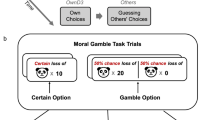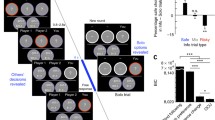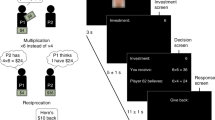Abstract
Investigation of neural and cognitive processes underlying individual variation in moral preferences is underway, with notable similarities emerging between moral- and risk-based decision-making. Here we specifically assessed moral distributive justice preferences and non-moral financial gambling preferences in the same individuals, and report an association between these seemingly disparate forms of decision-making. Moreover, we find this association between distributive justice and risky decision-making exists primarily when the latter is assessed with the Iowa Gambling Task. These findings are consistent with neuroimaging studies of brain function during moral and risky decision-making. This research also constitutes the first replication of a novel experimental measure of distributive justice decision-making, for which individual variation in performance was found. Further examination of decision-making processes across different contexts may lead to an improved understanding of the factors affecting moral behaviour.

Similar content being viewed by others
Notes
See [5] for a further comparison of insula involvement in moral and non-moral decision-making outside of the distributive justice context.
References
Hsu, M., C. Anen, et al. 2008. The right and the good: Distributive justice and neural encoding of equity and efficiency. Science 320: 1092–1095.
Sanfey, A.G., J.K. Rilling, et al. 2003. The neural basis of economic decision-making in the Ultimatum Game. Science 300: 1755–1758.
Knutson, B., and S.M. Greer. 2008. Anticipatory affect: Neural correlates and consequences for choice. Philosophical Transactions of the Royal Society B 363: 3771–3786.
Lawrence, N.S., F. Jollant, et al. 2008. Distinct roles of prefrontal cortical subregions in the Iowa gambling task. Cerebral Cortex 19: 1134–1143.
Shenhav, A., and J.D. Greene. 2010. Moral judgments recruit domain-general valuation mechanisms to integrate representations of probability and magnitude. Neuron 67: 667–677.
Tobler, P.N., A. Kalis, et al. 2008. The role of moral utility in decision-making: An interdisciplinary framework. Cognitive, Affective, & Behavioral Neuroscience 8: 390–401.
Hare, T.A., C.F. Camerer, et al. 2010. Value computations in ventral medial prefrontal cortex during charitable decision making incorporate input from regions involved in social cognition. The Journal of Neuroscience 30: 583–590.
Tricomi, E., A. Rangel, et al. 2010. Neural evidence for inequality-averse social preferences. Nature 463: 1089–1091.
de Quervain, D.J.-F., U. Fischbacher, et al. 2004. The neural basis of altruistic punishment. Science 305: 1254–1258.
Xue, G., Z. Lu, et al. 2009. Functional dissociations of risk and reward processing in the medial prefrontal cortex. Cerebral Cortex 19: 1019–1027.
Knoch, D., and E. Fehr. 2007. Resisting the power of temptations. The right prefrontal cortex and self-control. Annals of the New York Academy of Sciences 1104: 123–134.
Bechara, A., D. Tranel, et al. 2000. Characterization of the decision-making deficit of patients with ventromedial prefrontal cortex lesions. Brain 123: 2189–2202.
Buelow, M.T., and J.A. Suhr. 2009. Construct validity of the Iowa gambling task. Neuropsychology Review 19: 102–114.
Brand, M., E.C. Recknor, et al. 2007. Decisions under ambiguity and decisions under risk: Correlations with executive functions and comparisons of two different gambling tasks with implicit and explicit rules. Journal of Clinical and Experimental Neuropsychology 29: 86–99.
Rogers, R.D., A.M. Owen, et al. 1999. Choosing between small, likely rewards and large, unlikely rewards activates inferior and orbital prefrontal cortex. The Journal of Neuroscience 20: 9029–9038.
Fishbein, D., C. Hyde, et al. 2005. Cognitive performance and autonomic reactivity in abstinent drug abusers and nonusers. Experimental and Clinical Psychopharmacology 13: 25–40.
Lejuez, C.W., J.P. Read, et al. 2002. Evaluation of a behavioral measure of risk taking: The Balloon Analogue Risk Task (BART). Journal of Experimental Psychology: Applied 8: 75–84.
Lejuez, C.W., W.M. Aklin, et al. 2003. The Balloon Analogue Risk Task (BART) differentiates smokers and nonsmokers. Experimental and Clinical Psychopharmacology 11: 26–33.
Dahlbäck, O. 1990. Personality and risk-taking. Personality and Individual Differences 11: 1235–1242.
Cohen, B.H., and R. Brooke Lea. 2004. Essentials of statistics for the social and behavioral sciences. Chichester: Wiley.
Steiger, J.H. 1980. Tests for comparing elements of a correlation matrix. Psychological Bulletin 87: 245–251.
Fehr, E., and U. Fischbacher. 2004. Third-party punishment and social norms. Evolution and Human Behavior 25: 63–87.
Franken, H.A., J.W. Van Strien, et al. 2008. Impulsivity is associated with behavioral decision-making deficits. Psychiatry Research 158: 155–163.
Monterosso, J., R. Ehrman, et al. 2001. Three decision-making tasks in cocaine-dependent patients: Do they measure the same construct? Addiction 96: 1825–1837.
Skeel, R.L., J. Neudecker, et al. 2007. The utility of personality variables and behaviorally-based measures in the prediction of risk-taking behavior. Personality and Individual Differences 43: 203–214.
Skeel, R.L., C. Pilarski, et al. 2008. Personality and performance-based measures in the prediction of alcohol use. Psychology of Addictive Behaviors 22: 402–409.
Upton, D.J., A.J. Bishara, et al. 2011. Propensity for risk taking and trait impulsivity in the Iowa Gambling Task. Personality and Individual Differences 50: 492–495.
Loewenstein, G., S. Rick, et al. 2008. Neuroeconomics. Annual Review of Psychology 59: 647–672.
Huettel, S.A. 2010. Ten challenges for decision neuroscience. Frontiers in Neuroscience 4: 1–7.
Tversky, A., and D. Kahneman. 1981. The framing of decisions and the psychology of choice. Science 211: 453–458.
Greene, J.D., R.B. Sommerville, et al. 2001. An fMRI investigation of emotional engagement in moral judgment. Science 293: 2105–2108.
Rachels, J., and S. Rachels (eds.). 2010. The elements of moral philosophy, 6th ed. Boston: McGraw-Hill.
Henrich, J., R. Boyd, et al. 2005. “Economic man” in cross-cultural perspective: Behavioral experiments in 15 small-scale societies. Behavioral and Brain Sciences 28: 795–855.
Zyphur, M.J., J. Narayanan, et al. 2009. The genetics of economic risk preferences. Journal of Behavioral Decision Making 22: 367–377.
Adida, M., L. Clark, et al. 2008. Lack of insight may predict impaired decision making in manic patients. Bipolar Disorders 10: 829–837.
Acknowledgements
This work was supported by an Australian Research Council Discovery grant (DP 0988514) to JH. TTN is supported by the National Health and Medical Research Council (ID 490976). SMM is supported by the Victorian Neurotrauma Initiative (DF05) and the National Health and Medical Research Council. We thank Dinah Cragg for assistance with the DJT analysis, and Anthony Hannan for comments on an earlier version of the manuscript. The authors declare no conflicts of interest.
Author information
Authors and Affiliations
Corresponding author
Electronic supplementary material
Below is the link to the electronic supplementary material.
Online Resource
Contains details of the slideshow employed in the distributive justice task and a description of the method for calculating the inequity-aversion parameter. (PDF 203 kb)
Rights and permissions
About this article
Cite this article
Palmer, C.J., Paton, B., Ngo, T.T. et al. Individual Differences in Moral Behaviour: A Role for Response to Risk and Uncertainty?. Neuroethics 6, 97–103 (2013). https://doi.org/10.1007/s12152-012-9158-4
Received:
Accepted:
Published:
Issue Date:
DOI: https://doi.org/10.1007/s12152-012-9158-4




